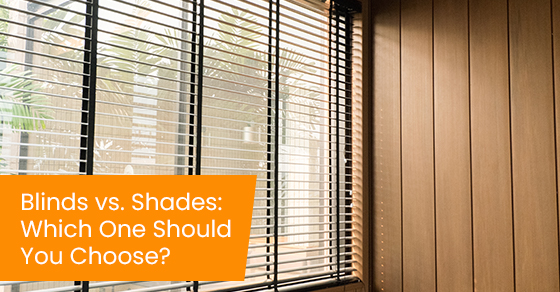
Blinds vs. Shades: Which One Should You Choose?
When putting in the final touches to make your house into a home, one aspect you should consider is window treatments. Curtains, blinds, shades and shutters can make a huge difference in your home, all while allowing for more privacy and light control. Two of the most popular choices for window treatments are blinds and shades.
As a homeowner, you may wonder what the difference between the two is. You may also be wondering which option would be better suited for your home and your family’s needs. This article will further discuss the differences and similarities between blinds and shades.
Hopefully, this will help in making your decision that much easier!
What’s The Difference Between Blinds and Shades?
Ultimately, the difference between blinds and shades comes down to their construction. Blinds feature the following:
- Multiple slats that can be tilted to open or close to specific degrees
- Come with either horizontal or vertical slats
- Have a variety of different materials such as bamboo, vinyl, wood or aluminum
Comparatively, shades feature:
- Single window covers that are pulled open or closed
- Come in softer materials
- Popular types of shades include Roman, cellular, and roller shades
While there are differences in material and form between blinds and shades, both window treatments are quite effective in controlling and filtering light within the home.
Lighting Control
Light filtering and control refer to how much or how little light a window treatment allows into the home. Some popular window treatments can completely blackout a room, whereas others only offer light-filtering capabilities. With blinds, you can tilt the slats to any degree to get the desired light.
With shades, however, you get less control as there is only one single window covering. Shades are usually a better option to completely darken or blackout a room. They can additionally diffuse light and create a warm ambiance.
Although blinds offer more light control, you can use either blinds or shades to fully raise them, allowing light in or fully closing them to block light.
Costs
Which option is more wallet-friendly when choosing between blinds and shades? Ultimately, blinds are usually the less expensive option as opposed to shades. They are hassle-free and convenient. You should keep in mind, though, that high-end blinds can cost more than simple shades.
It all depends on the materials used and if you decide on luxury, you may end up paying more even if you go for blinds.
Maintenance
As shades are only one single piece of window covering, they are generally easier to clean with a vacuum attachment or when doing touch-ups around the house. Blinds may require more diligent cleaning and dusting.
Many other factors come into play when it comes to the maintenance of your window treatments. For example, consider where to place your window treatments. If you have kids or pets making messes regularly, you may also want to factor that in.
Window treatments installed in high-traffic areas, such as living rooms and entryways, usually require more frequent cleaning.
Insulating Features
If you’re looking for a window treatment with insulating features, opt for shades instead of blinds. Blinds work better at creating airflow than retaining heat. However, many different kinds of shades on the market are great at insulating, preventing warm air from escaping outside and blocking the sun’s UV rays.
Some insulating style shades you may want to look into are cellular shades and Roman shades. Cellular shades are widely regarded as the most energy-efficient type of window treatment, as their unique honeycomb style allows for better insulation than other coverings.
Safety
Shades certainly have an advantage over blinds when it comes to safety around children, pets and older adults. The advantage is that most blinds come with cords that can pose a hazard for kids and small children.
If you do have kids and pets in your household, you should instead opt for cordless blinds. Automated blinds may be pricier, but they are also cordless and safer for children. After all, better safe than sorry.
Amount of Privacy
With both blinds and shades, you can obtain privacy inside your home. Blinds can be tilted and adjusted to block out certain viewpoints. They can be fully closed for more obscurity. Homeowners can pull down shades to allow for greater privacy within the home.
One thing to remember about shades is that the amount of privacy you get from them is also largely dependent on the materials you choose. While some fabrics can be sheer and you can still see figures through them. Other materials are much thicker and do not allow any light through them.
Consult With a Professional
While both blinds and shades can be great options for homeowners, it’s normal to question which is truly the best fit for your home.
If you are still trying to decide the type of window treatments you need, it’s best to consult a professional who can give you some tips and tricks to help guide you. Never be afraid to ask for a consultation to get a better idea of your personal situation.
Adding window treatments to your home, such as blinds and shades, can make all the difference. Conduct your research before looking for window treatments, as the number of options available can be overwhelming.
However, regardless of what you decide to do, know that both blinds and shades effectively filter and control light, giving privacy and boosting ambiance in the home.
For more information on window shades and coverings, please get in touch with Window Blinds Direct at 647-360-7026 or contact us here. Our professionals can help you make the best decision for your home. Contact us today for more information on our selection of window treatments.

Leave A Comment